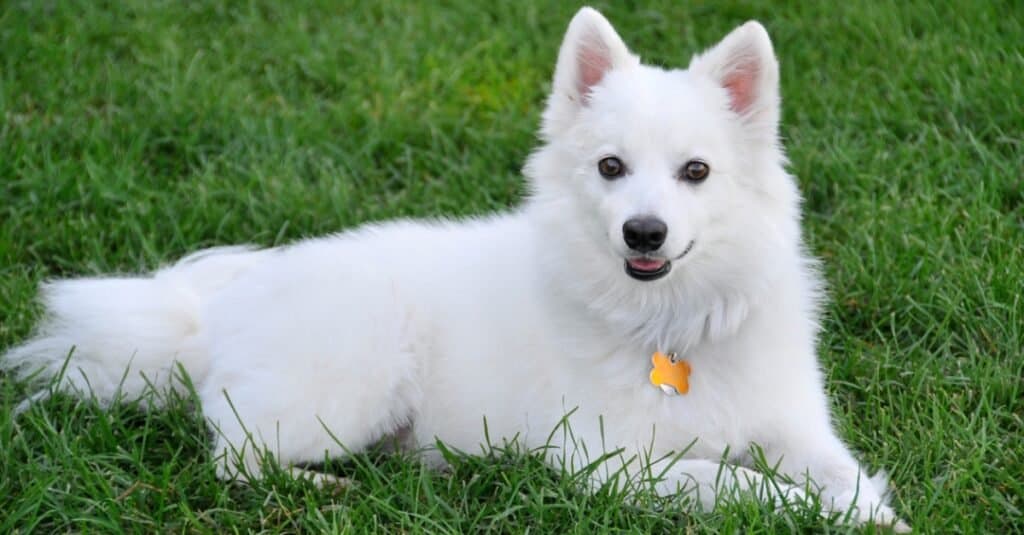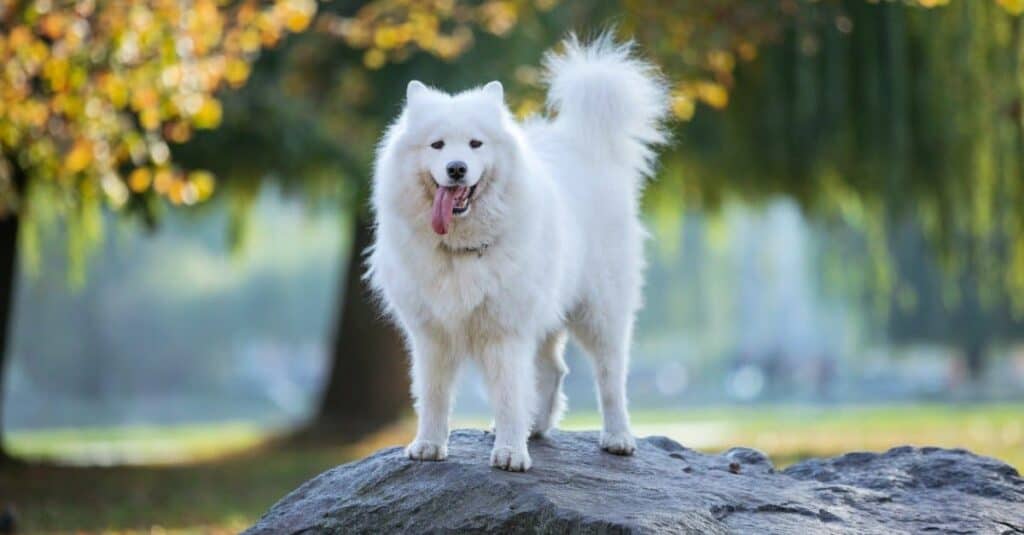Arguably one of the best romantic comedies of all time is the 2009 film, The Proposal. The movie was a box office hit, breaking romantic comedy records with $317 million dollars in ticket sales. However, even with a star-studded cast including Sandra Bullock, Ryan Reynolds, and Betty White, it was actually the little white dog in The Proposal who easily stole the show! Audiences couldn’t get enough of the tiny and fluffy pooch and his death-defying adventures with the eagle. But what kind of dog is in the movie The Proposal?
What Kind of Dog Is in the Movie ‘The Proposal’?
The Dog in the movie The Proposal is an American Eskimo / Samoyed. Kevin — the family’s beloved fluffy white pup in the movie — was actually played by four different canine actors: Sitka, Winter, Nanu, and Flurry. These fluffy pups each took turns bringing Kevin’s character to life on screen.
However, of the four pups, it was Flurry who stole the hearts of the film’s cast and crew. In one of the most iconic and memorable scenes in the film, we see poor little Kevin (as played by Flurry) snatched up into the sky by an enormous eagle! Fortunately, the eagle drops the adorable pup but takes Margaret’s (Sandra Bullock) phone instead. Margaret holds the dog up to the sky, offering Kevin as a sacrifice in exchange for her cell phone. The scene is both hilarious and nerve-wracking, endearing this cute little dog in the hearts of viewers around the world.
But don’t worry, although the film crew used two live Australian wedged-tailed eagles for the scene shot, the dog was always filmed separately. And while Bullock’s on-screen character isn’t a fan of Kevin in the film, behind the scenes the actress bonded with Flurry. When filming the memorable eagle scene, Bullock cradled the small pup in her bathrobe. She continually apologized to him, reassuring Flurry that she would never try to hurt him. In fact, the two became so close that the dog refused to bark at her, even when prompted to do so for a scene!

All the cast and crew members on the set of the movie
The Proposalfell in love with the film’s dog actors.
©iStock.com/blendshapes
American Eskimo
Appearance
Despite its name, the American Eskimo dog breed actually originated in Germany (during World War I, the breed’s name was changed from the “German Spitz” to the “American Eskimo” due to the anti-german sentiment at the time). Bred as versatile working dogs, they were perfect for pulling sleds, herding, and serving as watchdogs. German immigrants brought American Eskimo dogs to the U.S. in the early 1900s, where they quickly captured the hearts of Americans thanks to their natural intelligence and charm. Soon enough, American Eskimos were star performers in dog shows, circuses, and even Hollywood productions.
Today, there are three different sizes of these gorgeous dogs: standard, miniature, and toy. They range in size from 9 to 19 inches tall at the shoulder and 6 to 35 pounds. But no matter what size, all American Eskimo dogs have a distinctive appearance with stunning white coats. Their fur is dense and seems to sparkle and requires regular grooming. They also have a majestic mane of gorgeous fur around their chests and shoulders, making them look like tiny little white lions. However, although most dogs are pure white, there are a lucky few that have beautiful markings ranging from cream to biscuit.
In addition to their beautiful fur coats, American Eskimos also have an unmistakable smile! With their black eye rims, lips, and cute little nose, their faces seem to convey a thoughtful and intelligent expression. They often look as if they are smiling from ear to ear. And of course, they have that stunning plumed tail, which they hold high over their backs.

American Eskimo dogs come in three different sizes, ranging from just 6 inches tall to 19 inches tall.
©T and Z/Shutterstock.com
Behavior
In addition to their stellar good looks, American Eskimos have lovable personalities, a quick wit, and a natural charm. They are typically alert and friendly, but they can be a bit cautious when they meet new people. However, these cute little fluffballs open up pretty quickly.
In fact, American Eskimo dogs are social creatures through and through! They crave human interaction and attention, and they can develop problematic behaviors if they feel neglected or if they are undertrained. Being a part of the family is unnegotiable for an American Eskimo — they insist on being right in the middle of everything that’s going on.
Fortunately, American Eskimo dogs are extremely intelligent dogs and are some of the most trainable out there. They have a natural eagerness to please that makes them fun to work with, whether you’re teaching them new tricks or just spending quality time together. They are also very kid-friendly, with a gentle and patient nature that makes them ideal companions for all ages.

American Eskimo dogs are beautiful, fun, and friendly, but they can sometimes be stubborn.
©Hendrickson Photography/Shutterstock.com
Samoyed
Appearance
Beautiful and hardy, the Samoyed is a spitz-type breed that hails from the rugged lands of Siberia. These dogs are famous for their stunning white double-layer coats. Their fur is naturally dirt-repellent and insulates their bodies from the frigid Siberian climate. Samoyeds are medium-sized dogs that grow 19 to 23.5 inches at the shoulder and weigh 35 to 65 pounds. With soulful, almond-shaped eyes and a thick bushy tail carried proudly over the back, Samoyeds are truly stunning canines.
However, their beauty does come with a price — Samoyeds are high-maintenance dogs and shed a lot. Their luscious coats require regular grooming to keep them shiny, clean, and matt free. This can be tricky, as Samoyeds are energetic dogs who love to romp, play, and seek out adventure.

Samoyed originally were working dogs who herded
reindeer
and hunted.
©iStock.com/Abramova_Kseniya
Behavior
Samoyeds were originally bred by the Samoyed peoples of Siberia as working dogs. However, it was not just their strength and stamina that made these pups invaluable — Samoyeds also had a special place in the hearts of their human companions. They pulled sleds and hunted, but they were also kept as pets and cherished for their loyal and loving nature.
The Samoyed breed came to Europe in the late nineteenth century and soon it was all the rage in the show ring and as a canine companion. These special dogs were and are still popular because of their fluffy white coats, friendly personalities, and undeniable charm.
Next to their stunning appearance, Samoyeds are best known for their friendly and playful personalities. They are social butterflies who thrive on human interaction. Samoyeds will happily welcome both young children and adults into their world with open paws. They also get along splendidly with other pets as well, making them great additions to multi-animal households. Samoyeds are also cuddly, affectionate, and always ready for a snuggle session on the couch.
Playful and adventurous, Samoyeds are always up for a game of fetch or a romp in the park. They are active dogs who were originally bred to work, so they need plenty of daily exercise and lots of playtime. Samoyeds also have a tendency to escape and can roam for miles, so you’ll have to be sure that your fence is secure and that you always keep an eye on your adventurous pup. In addition, Samoyeds are notorious barkers, and many of them really love to dig. However, with the right environment and training, Samoyeds can make some of the best canine companions out there!

Samoyeds are excellent companions, but they can be high maintenance. They need lots of exercise, attention, and grooming.
©iStock.com/photobac
The Real Question from The Proposal: Could An Eagle Take a Dog?
After witnessing the nail-biting eagle scene with the dog in the movie The Proposal, many people want to know if that could ever happen in real life. That is, could an eagle actually snatch up your furry friend? Well, unfortunately, the answer isn’t so straightforward. According to the Alaska Department of Fish and Game, there are many factors at play in such a scenario.
For example, the size and the speed at which the bird is flying. If the eagle is leisurely gliding through the skies at a slower speed, then it can only handle small loads like fish. However, if the bird is diving down at high speeds of 20 to 30 mph, it can carry much more weight. The increased momentum and speed give the eagle more lift potential, making it easier to pick up and fly away with a 6 to 8-pound dog. However, if the eagle is stationary, lifting that weight will be very difficult. So, if you’re out playing with your furry friend and spot an eagle overhead, be sure to keep a vigilant eye on them!
The photo featured at the top of this post is © Sergii Chernov/Shutterstock.com
Ready to discover the top 10 cutest dog breeds in the entire world?
How about the fastest dogs, the largest dogs and those that are -- quite frankly -- just the kindest dogs on the planet? Each day, AZ Animals sends out lists just like this to our thousands of email subscribers. And the best part? It's FREE. Join today by entering your email below.
Thank you for reading! Have some feedback for us? Contact the AZ Animals editorial team.






